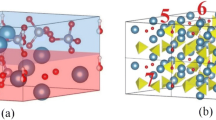Summary
Carboxyl-containing molecules can bind to HA with sufficient affinity to prevent the uptake of AZ by this mineral. Structural features that favor binding can be discerned. Isolated carboxyls are inactive; adjacent dicarboxylic functions are marginally active. Crowding of oxygens in the form of vicinal carboxyls or hydroxyls contributes the property of HA binding ability. This property exhibits gradation in magnitude and the variation can be correlated with structural features of the carboxylcontaining molecule. Phospho functions are generally more powerful contributors to HA binding property than are carboxyls.
Similar content being viewed by others
References
Voegel JC, Belcourt A, Gillmeth S (1981) The adsorption of salivary glycoproteins to fluoride-treated synthetic hydroxyapatites. J Coll Interface Sci 79:237–242
Francis MD, Slough CL, Briner WW, Dertel RP (1977) An in vitro and in vivo investigation of mellitate and ethane-1-hydroxy-1, 1-diphosphonate in calcium phosphate systems. Calcif Tissue Res 23:53–60
Napper DH, Smythe BM (1966) The dissolution kinetics of hydroxyapatite in the presence of kink poisons. J Den Res 45:1775–1783
Kresak M, Moreno EC, Zahradnik RT, Hay DI (1977) Adsorption of amino acids onto hydroxyapatite. J Coll Interface Sci 59:283–292
Klein CPAT, deGroot K, Vermeiden JPW Van Camp G (1980) Interaction of some serum proteins with hydroxyapatite and other materials. J Biomed Mater Res 14:705–712
Misra DH, Bowen RL, Antonucci JM, Cuthrell WF (1980) Adsorption of polyfunctional surface—active amino accelerator on hydroxyapatite. J Coll Interface Sci 77:143–150
Christoffersen J, Christoffersen MR (1981) Kinetics of dissolution of calcium hydroxyapatite. IV. The effect of some biologically important inhibitors. J Crystal Growth 53:42–54
Hunt DE, Hunt JK (1970) Adsorption of the antibiotic actinobolin by hydroxyapatite. Arch Oral Biol 25:431–434
Myers HM (1982) Orientation of adsorbed alizarin red S on hydroxyapatite. Calcif Tissue Int 34:557–561
Kukura M, Bell LC, Posner AM, Quirk JP (1972) Radioisotope determination of the surface concentrations of calcium and phosphorus on hydroxyapatite in aqueous solution. J Phys Chem 76:900–904
Darlow SF (1961) The crystal structure of mellitic acid. Acta Cryst 14:159–166
Mo F, Adman E (1975) Crystal structure of hemimellitic acid dihydrate. Acta Cryst 31:B:192–198
Cannon K, Kibrick A (1938) Complex formation between carboxylic acids and divalent metal ions. JACS 60:2314–2320
Nancollas GH, et al. (1978) Chemistry of waste water technology. AJ Rubin (ed) Ann Arbor Science Inc., pp 17–30
Brecevic LJ, Furedi-Milhofer H (1979) Precipitation of calcium phosphates from electrolyte solutions. V. The influence of citrate ions. Calcif Tissue Int 28:131–136
Addadi L, Weiner (1985) Interactions between acidic proteins and crystals: stereochemical requirements in biomineralization. PNAS 82:4110–4114
Author information
Authors and Affiliations
Rights and permissions
About this article
Cite this article
Myers, H.M. Structure-activity relationships (SAR) of hydroxyapatite-binding molecules. Calcif Tissue Int 40, 344–348 (1987). https://doi.org/10.1007/BF02556697
Received:
Revised:
Issue Date:
DOI: https://doi.org/10.1007/BF02556697




